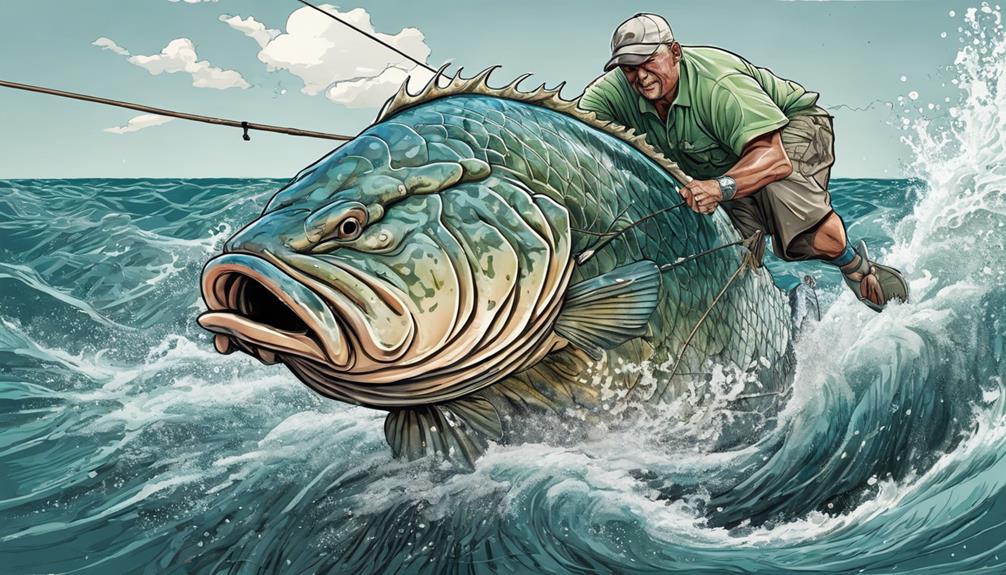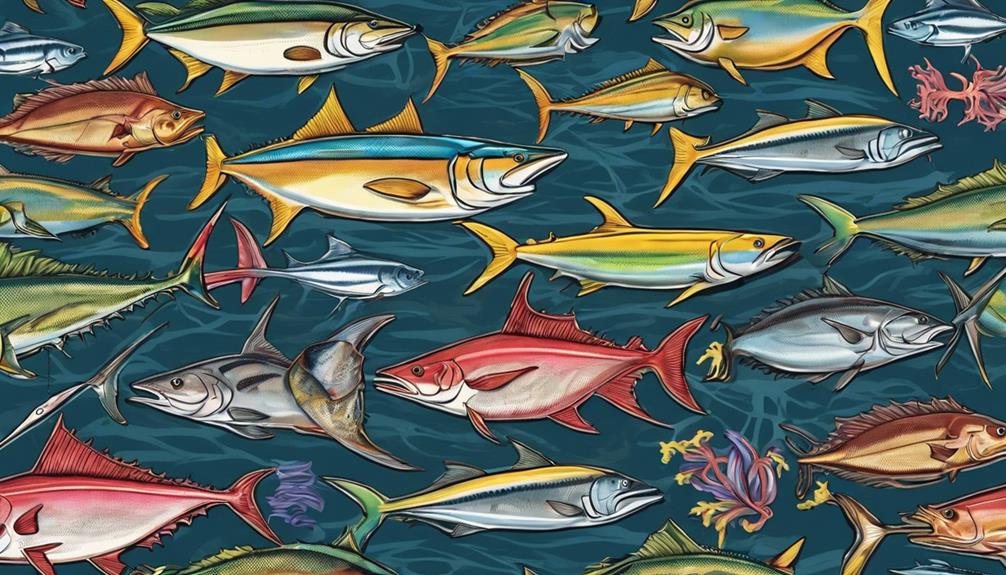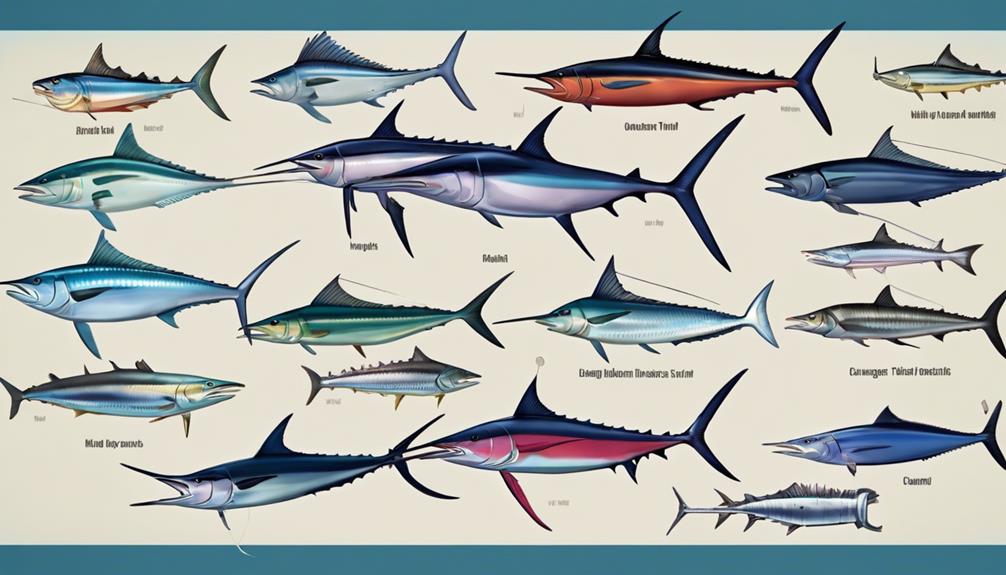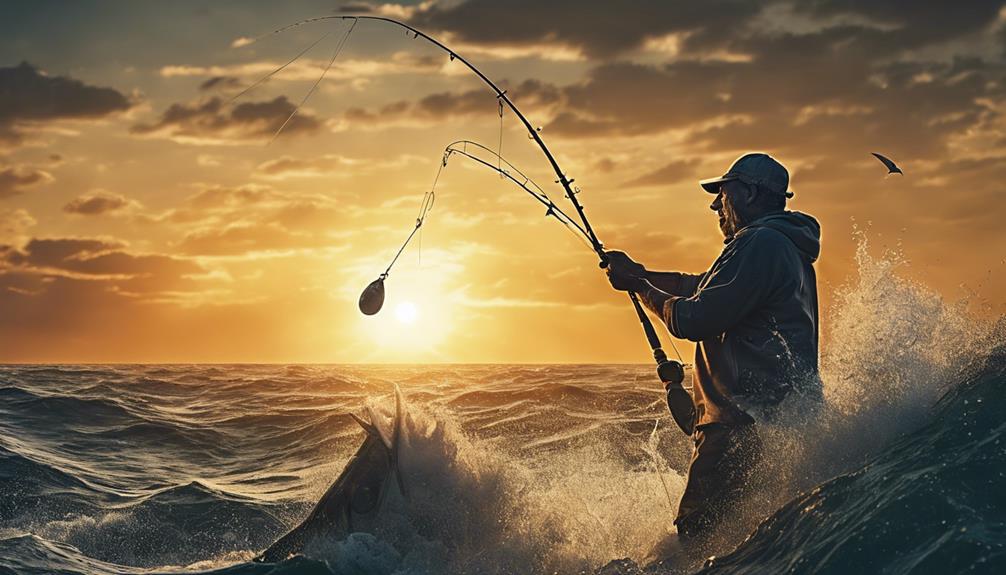When you're out on the open sea, there's a thrill in reeling in a massive yellowfin tuna. But have you ever wondered what other impressive species frequent the depths?
From the majestic marlin to the powerful swordfish, the top 13 deep sea fishing species hold a sense of mystery and challenge that keeps anglers coming back for more.
So, which elusive creature will test your skills next?
Tuna
When deep sea fishing, you frequently catch tuna, a prized species known for its strength and speed. Tuna conservation is crucial in maintaining the population of these magnificent fish for future generations to enjoy. By following guidelines such as adhering to catch limits and using sustainable fishing practices, you can contribute to the preservation of tuna populations in the oceans.
Apart from conservation efforts, tuna can also be enjoyed in various delicious recipes. Whether you prefer seared tuna steaks, grilled tuna kebabs, or classic tuna salad sandwiches, there are countless ways to savor the rich flavor and firm texture of this popular fish. Tuna recipes are versatile and can cater to different tastes and culinary preferences, making it a favorite choice for many seafood enthusiasts.
In addition to its culinary appeal, tuna also offers numerous health benefits. It's a great source of lean protein, omega-3 fatty acids, and essential nutrients like vitamin D and selenium. Including tuna in your diet can help support heart health, brain function, and overall well-being.
Next time you reel in a tuna while deep sea fishing, consider the importance of tuna conservation and explore new recipes to enjoy this prized species both on and off the water.
Mahi-Mahi
Frequently caught while deep sea fishing, Mahi-Mahi is a vibrant and popular species known for its striking colors and delicious taste. Mahi-Mahi, also known as dolphinfish or dorado, is a highly sought-after fish due to its bright green, blue, and yellow hues that adorn its sleek body. This species' sustainable harvesting practices have made it a favorite among anglers and seafood enthusiasts alike.
When it comes to culinary delights, Mahi-Mahi is prized for its firm texture and mild, sweet flavor. Its versatility in the kitchen makes it a top choice for grilling, searing, or even ceviche. The meaty flesh of Mahi-Mahi holds up well to various cooking methods, allowing for a wide range of delectable dishes to be prepared.
In addition to its culinary appeal, Mahi-Mahi is known for its rapid growth rate and abundance in the wild, contributing to its sustainable harvesting status. This fish's resilience to fishing pressure has made it a responsible choice for those looking to enjoy seafood without compromising the health of ocean ecosystems.
Marlin
Mahi-Mahi, a vibrant and popular species frequently caught while deep sea fishing, shares the waters with another impressive gamefish – Marlin. Marlin are known for their incredible speed and acrobatic jumps when hooked, making them a thrilling challenge for anglers. Here's a closer look at Marlin:
- Majestic Creatures: Marlin are majestic creatures with their long, sword-like bills and striking colors that shimmer in the sunlight as they cut through the water.
- Conservation Efforts: Due to overfishing in the past, there have been significant Marlin conservation efforts worldwide, promoting catch and release practices to ensure the sustainability of Marlin populations.
- Fishing Tournaments: Marlin fishing tournaments attract anglers from around the globe, showcasing impressive trophy sizes and records. These events celebrate the sport of deep sea fishing while also raising awareness about Marlin conservation.
- Record Catches: Marlin hold prestigious records in the fishing world, with some individuals reaching sizes of over 1,000 pounds. Anglers dream of landing a Marlin that could potentially break existing records and earn them a place in fishing history.
Marlin represent the epitome of deep sea fishing excitement, embodying both the thrill of the chase and the importance of responsible angling practices for future generations to enjoy.
Swordfish
Swordfish, a powerful and sought-after species in deep sea fishing, captivate anglers with their impressive size and fierce fighting ability. These giants of the ocean can reach lengths of over 10 feet and weigh upwards of 1,000 pounds, providing an exhilarating challenge for any angler lucky enough to hook one.
When it comes to swordfish conservation, sustainable practices are crucial to ensure the longevity of this species. Overfishing has posed a significant threat to swordfish populations in the past, leading to regulations on catch limits and fishing methods. By adhering to these guidelines, anglers can help preserve swordfish populations for future generations to enjoy.
In terms of culinary trends, swordfish is a versatile fish that can be prepared in various ways to tantalize your taste buds. From grilling and broiling to searing and baking, swordfish steaks offer a meaty texture and mild flavor that pairs well with a variety of seasonings and sauces. Popular swordfish cooking recipes include lemon herb swordfish, Cajun-spiced swordfish, and Mediterranean-style swordfish kebabs.
Wahoo
When targeting Wahoo in deep sea fishing, anglers are in for an exciting challenge due to the speed and agility of this prized species. Wahoo, also known as Ono in Hawaii, are known for their powerful runs and sharp teeth.
Here are some tips to enhance your Wahoo fishing experience:
- High-Speed Lures: Use fast-moving lures like jet heads or diving plugs to entice Wahoo, mimicking their prey and triggering a strike.
- Wire Leaders: Wahoo have razor-sharp teeth that can easily cut through traditional leaders. Opt for wire leaders to prevent losing your catch.
- Trolling Depth: Wahoo are often found in deeper waters, so adjust your trolling depth accordingly to target this pelagic species effectively.
- Chumming Techniques: Deploying a well-thought-out chumming strategy can attract Wahoo to your boat, increasing your chances of a successful catch.
After a successful day of deep-sea fishing and reeling in a Wahoo, consider trying out some delicious Wahoo recipes. Grilled Wahoo steaks with a citrus marinade or blackened Wahoo tacos are popular choices among anglers.
Snapper
To increase your chances of catching Snapper during deep sea fishing trips, consider using live bait to attract these prized fish. Snappers are known for their sharp teeth and keen sense of smell, making live bait such as small fish or squid incredibly effective in luring them to your line. When targeting Snapper, it's essential to head to the best snapper fishing spots. Areas like the Gulf of Mexico, the Florida Keys, and the Great Barrier Reef are renowned for their abundant Snapper populations.
When it comes to techniques, Snapper fishing requires patience and skill. One effective method is bottom fishing using a weight to keep your bait near the sea floor where Snapper tend to hide. Keep your line tight and be prepared for a strong fight when a Snapper takes the bait.
Once you've reeled in your catch, it's time to explore delicious Snapper recipes and cooking tips. Snapper has a mild, slightly sweet flavor that pairs well with various seasonings and cooking methods. Whether you prefer grilling, baking, or pan-searing, Snapper can be a versatile addition to your culinary repertoire. Enjoy the fruits of your labor by trying out different Snapper dishes and impressing your family and friends with your fresh catch.
Grouper

Consider expanding your deep sea fishing repertoire by targeting Grouper, another exciting species frequently caught on these trips. Grouper, known for their powerful strikes and delicious meat, can provide an exhilarating fishing experience. Here are some key points to keep in mind when targeting this species:
- Grouper habitat preferences: These fish are commonly found near structures such as reefs, wrecks, and rock piles on the ocean floor. They prefer hiding in crevices or ledges waiting to ambush prey. When deep sea fishing for Grouper, look for these structures to increase your chances of a successful catch.
- Grouper conservation efforts: Due to overfishing and habitat destruction, many Grouper species are facing population declines. To help conserve Grouper populations, it's important to follow local fishing regulations, adhere to catch limits, and practice responsible fishing techniques. Consider catch-and-release practices for conservation purposes.
- Size and strength: Grouper are known for their size and strength, putting up a good fight when hooked. Be prepared for a challenging battle when reeling in these powerful fish.
- Varied species: There are various types of Grouper species, each with its unique characteristics and behaviors. From the colorful and elusive Goliath Grouper to the camouflage experts like the Black Grouper, each species offers a different angling experience.
Shark
With their formidable reputation and powerful presence, targeting sharks on deep sea fishing expeditions can provide an adrenaline-pumping thrill. Sharks are known for their predatory behavior, often displaying swift and decisive movements when hunting for prey. Their keen senses, particularly their acute sense of smell, help them locate food even from great distances. When hooked on a fishing line, sharks exhibit strength and agility, making them a challenging catch for anglers seeking a thrilling adventure.
Shark conservation efforts have become increasingly important due to the decline in shark populations worldwide. Overfishing and bycatch pose significant threats to these apex predators, impacting marine ecosystems. Many countries have implemented regulations to protect shark species, such as banning shark finning and establishing marine protected areas where sharks can thrive undisturbed. Conservationists also work to raise awareness about the importance of sharks in maintaining a balanced oceanic ecosystem and dispelling myths surrounding these creatures.
When participating in deep sea fishing expeditions targeting sharks, it's crucial to do so responsibly. By practicing catch and release techniques, respecting catch limits, and supporting shark conservation initiatives, you can enjoy the thrill of shark fishing while contributing to the preservation of these magnificent creatures for future generations to appreciate.
Frequently Asked Questions
What Are Some Common Deep Sea Fishing Techniques Used to Catch These Species?
To catch deep-sea species, try rod techniques like jigging and using electronic lures. Trolling rigs are also effective for attracting fish. Experiment with different bait sizes and colors to see what works best.
When jigging, vary your movements to mimic injured prey and entice bites. Stay patient and persistent, as deep-sea fishing can be unpredictable. Remember to adjust your techniques based on the species you're targeting for a successful day on the water.
Are There Any Specific Locations or Regions Where These Species Are More Commonly Found?
In global hotspots, you'll find specific locations teeming with deep-sea species. These areas boast regional variations in the types of fish commonly caught. Knowing the prime spots can improve your chances of landing your desired catch.
It's essential to research and understand the unique characteristics of each location to make the most out of your deep-sea fishing adventures. Happy fishing!
What Are Some Popular Bait Options for Targeting These Deep Sea Fishing Species?
When you're looking to reel in those deep sea beauties, using the best lures is key. Opt for live bait like squid, mackerel, or sardines for an enticing presentation.
Make sure to fish in optimal conditions, like during the early morning or late afternoon when the fish are most active.
Don't forget to adjust your bait size based on the target species you're after for a successful fishing trip.
Are There Any Regulations or Restrictions on Catching These Species to Be Aware Of?
When you're out on the water, it's important to be mindful of regulations and restrictions regarding deep-sea fishing.
Conservation efforts and sustainability practices play a crucial role in protecting marine life. Always check for catch and release guidelines and size limits to help maintain healthy fish populations.
Can These Deep Sea Fishing Species Be Found Year-Round or Are There Specific Seasons When They Are More Abundant?
You can find deep sea fishing species year-round, but certain times offer peak seasons when they're more abundant. Migration patterns and weather conditions play a role in their availability.
Best times to catch these species may vary depending on the specific species and location. By understanding the seasonal patterns and behaviors of these fish, you can increase your chances of a successful fishing trip.
Conclusion
So next time you're out on the water, keep an eye out for these top 13 deep sea fishing species.
With a little bit of luck and skill, you might just reel in a big catch like a tuna, mahi-mahi, or marlin.
Remember to stay patient and enjoy the thrill of the hunt as you try to land one of these prized fish.
Happy fishing!



